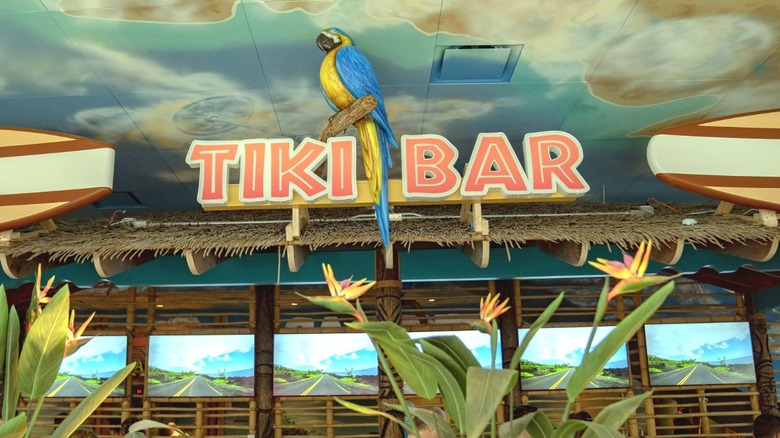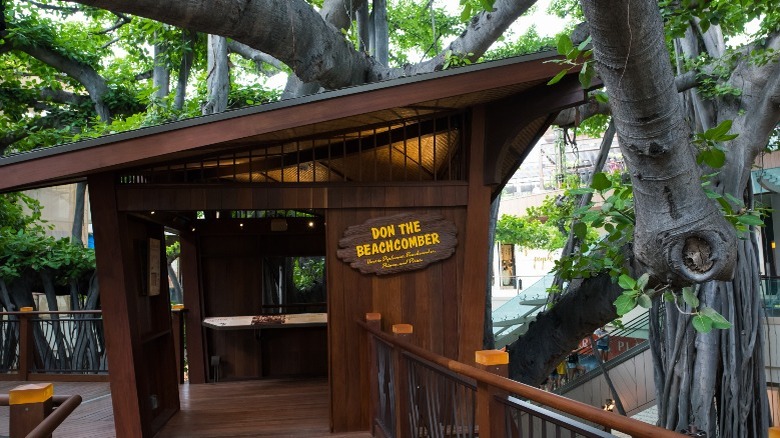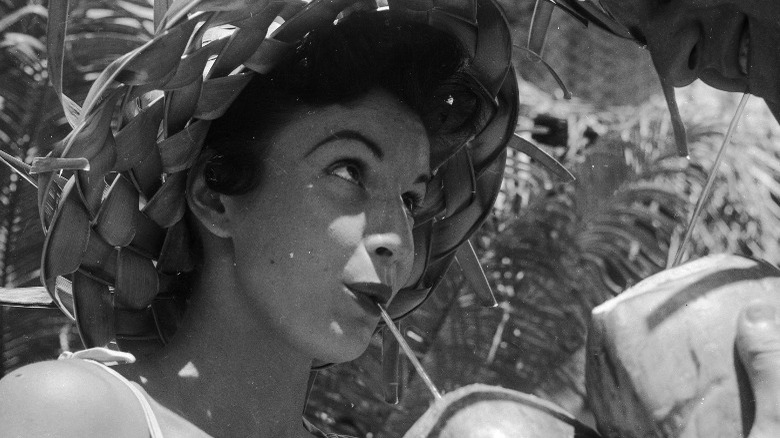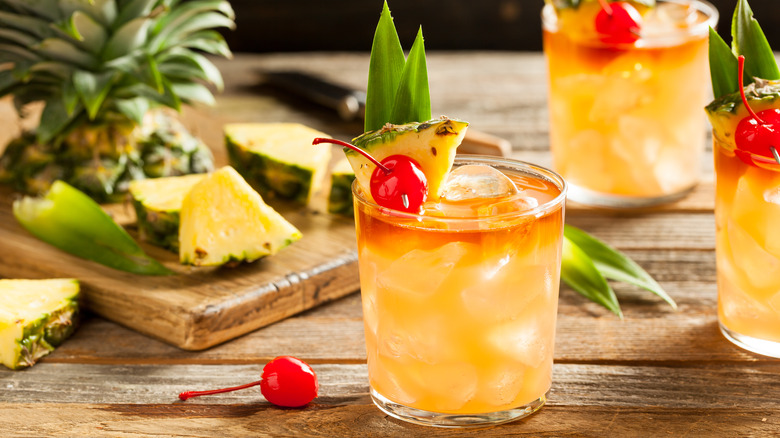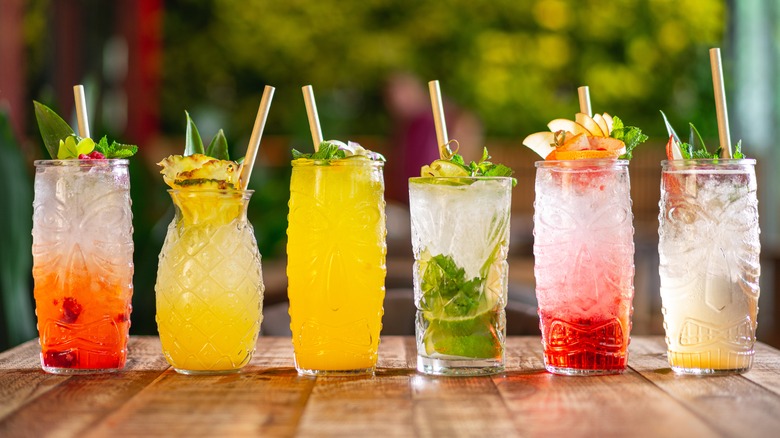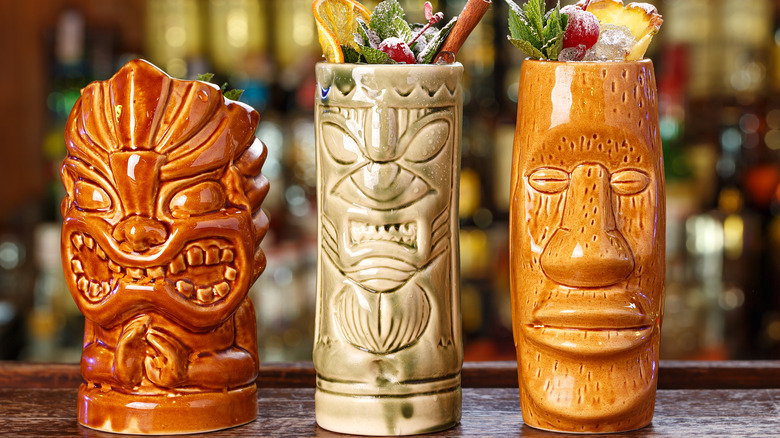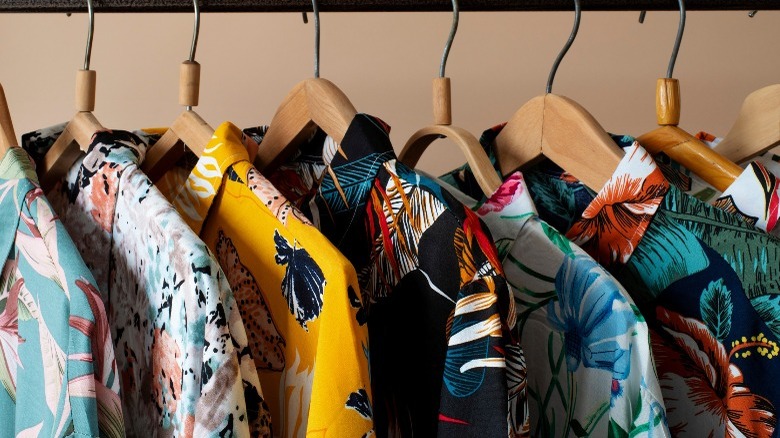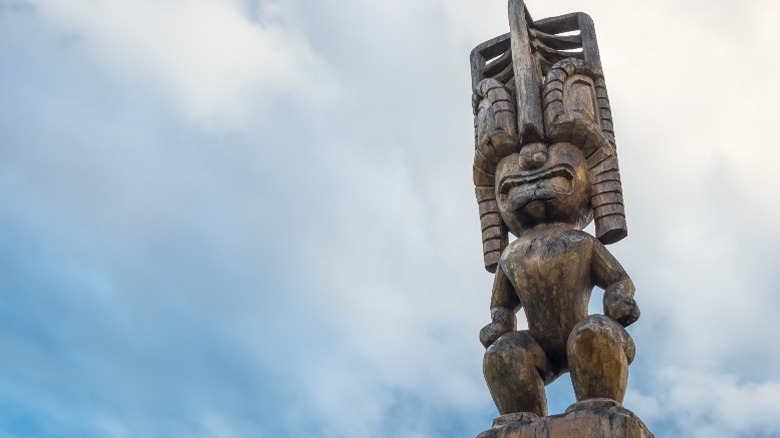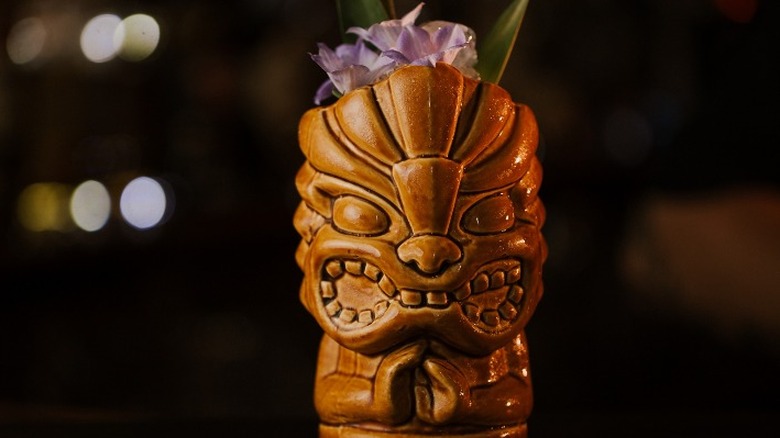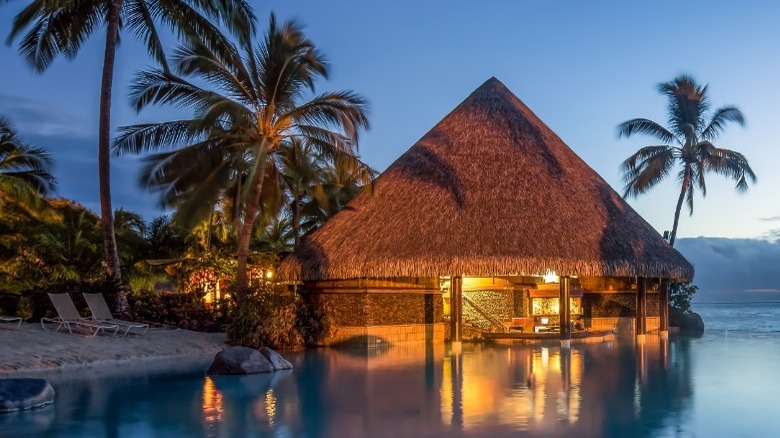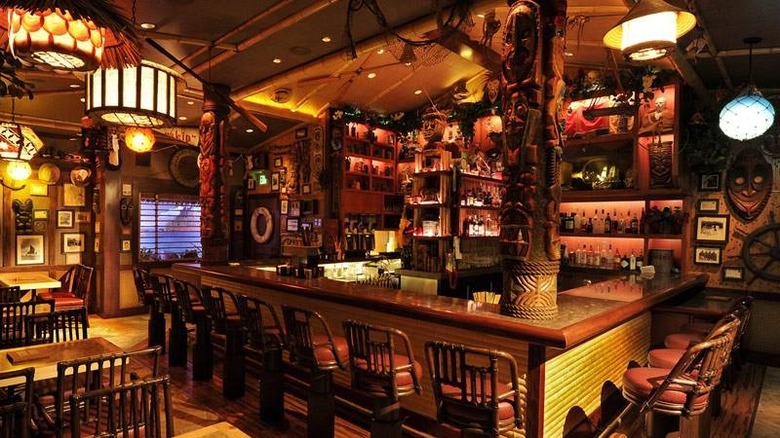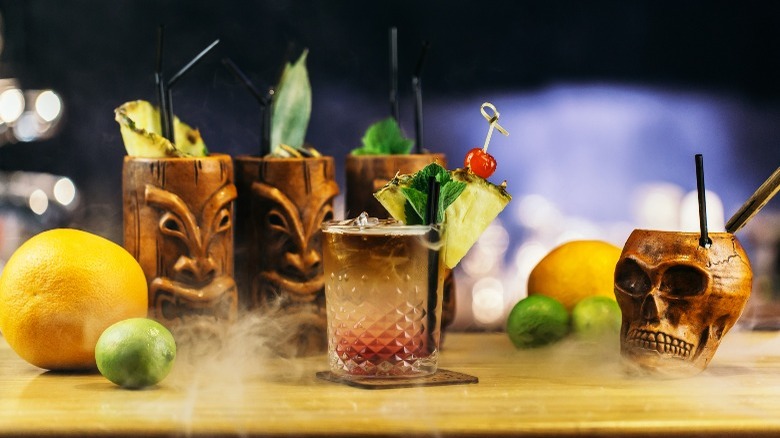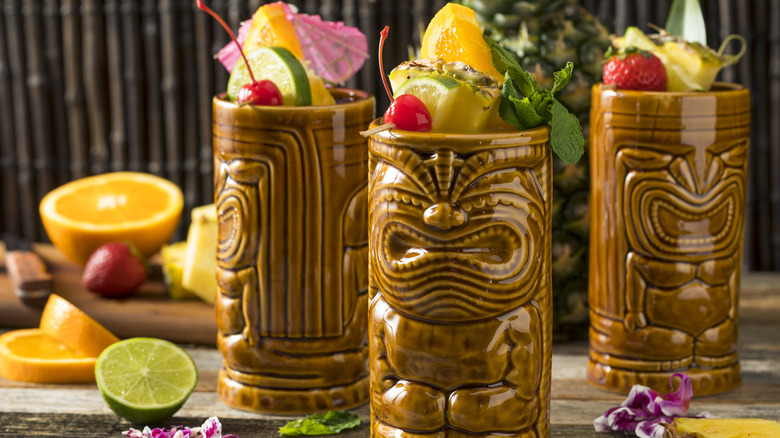The Untold Truth Of Tiki Bars
Tiki bars are many things to many people: kitschy throwbacks to another time, fun hangouts with tasty tropical drinks, or simply a tribute to that sweet island life. But there's more to these tropical lounges than just good times and great beverages. There's a somewhat sordid history to sort through, and a strange bit of coincidental competition that muddles the origins of tiki bars. And for the AAPI community, there's a stigma of racism and cultural appropriation that makes tiki bars an uncomfortable relic at best, and a harsh reminder of the reach of colonialism at worst. However, there is also hope to be found in the recent revival of tiki bars, which is shedding more troubling elements from the past in favor of a more craft-centered approach.
What troubling truths lie behind the advent of tiki bars, and what caused their popularity to rise and fall and rise again? What impact does such an old-fashioned concept have on modern culture, not just in the U.S., but all around the world? We set out on a voyage of discovery to find the real deal behind these precarious and popular watering holes. Grab a cocktail (preferably a fruity one) and read on for the untold truth of tiki bars.
Tiki bars originated in California
While it's reasonable to assume tiki bars originated in the tropics, the truth is much less exotic. In the early 1930s, a young American wanderer named Ernest Gantt returned to the U.S. after cavorting in the Caribbean and South Pacific and opened a Hollywood bar and restaurant that would come to be known as Don the Beachcomber (via American Heritage). Gantt decorated the bar with exotic finds from his travels and created elaborate cocktail creations evocative of the tropical destinations he visited. Gantt called them his Rhum Rhapsodies — the earliest iterations of the tiki drinks the world has come to know and love (via Senior & Co. Liqueur).
But the origin story doesn't end there. A few years after Gantt opened his tiki bar, another California restaurateur named Victor Bergeron decided to transform his Oakland restaurant, Hinky Dinks, from a lodge-style beer joint into a tiki oasis called Trader Vic's. Not coincidentally, the idea arose after Bergeron visited several other exotic-themed restaurants — one of which was the tiki bar that started it all, Don the Beachcomber (via Berkeleyside). Bergeron admitted to taking a few ideas from his predecessor — and just like Gantt, who had changed his name to Donn Beach, he even took on the name Trader Vic. As Bergeron told The New York Times, "I felt I could do it better." While that may be open to interpretation, Trader Vic's remains a well-known tiki bar chain to this day, with locations around the world.
They became popular after World War II
When troops returned from overseas after World War II, their experiences in the South Pacific kept their imaginations island bound. Paired with a post-war American boomtime and a need for escape from the work week, tiki bars took off, becoming a popular pastime that lasted longer than many other mid-century pop culture movements. As Martin Cate, owner and creator of San Francisco tiki bar Smuggler's Cove, explained to Smithsonian Magazine, during this era "these tiki bars become the place where everything slows down ... They became these shelters that you could go to to decompress." It was a form of escape for a work-weary society in desperate need of a colorful exit from the real world, if only for a drink or two.
The allure of the tiki bar continued into the '50s and '60s, but they became less popular after the Vietnam War overtook America's attention (via Wise Tour). Suddenly, the romantic fantasy of the islands had been replaced by a far darker reality. Though many remained open, it wasn't until the '90s that tiki bars experienced a beverage renaissance.
The Mai Tai was a controversial tiki bar invention
If a Mai Tai is the first drink that comes to mind when you think of tiki bars, you're not alone. In fact, the proprietors of Don the Beachcomber and Trader Vic's both claim it was one of the first tiki drinks that came to their minds, too. And as you can imagine, that created some controversy. Donn Beach's story was that he created a drink called the Q. B. Cooler, and then Trader Vic stole the formula to create what we now know as the famous Mai Tai — a drink name Donn claims he'd already come up with as well (via Letters and Liquor).
Meanwhile, Trader Vic tells a different tale, one in which he capitalized on the popularity of his other exotic drinks by opening 17-year-old bottle of rum and mixing it with lime, orange curaçao, sugar syrup, and Orgeat. After tasting this concoction, a friend from Tahiti declared "mai tai – roa ae," Tahitian for "out of this world – the best." Thus, the drink was named Mai Tai, and a legend was born. As the story goes, the success of Trader Vic's Mai Tai did not sit well with Donn Beach, who eventually sued. The contentious cocktail issue was put to rest in 1970, when a lawsuit was settled in favor of Trader Vic — who is credited to this day with creating arguably the most famous tiki cocktail there is (via Ultimate Mai Tai).
Tiki drinks follow a pretty simple formula
With so many punchy flavors available, it seems like any blend with juice and liquor can be called a tiki drink. While there are basic mixology rules that dictate what goes into a true tiki cocktail, and how much of each ingredient, it is certainly an artform open to interpretation. And with thrilling names like Painkiller, Zombie, and Singapore Sling, it's clear there's a lot of imagination that goes into these creations.
According to the father of tiki bars, Donn Beach himself, tiki drinks follow the formula of the Rum Rhapsodies — "one of sour, two of sweet, three of strong, four of weak" (via Senior & Co. Liqueur). That essential formula includes lime, sweetened syrup, alcohol (usually rum), and water or fruit juice. From there, the possibilities are endless. A classic rum punch is a great example of, not to mention a base for, building out other tiki drinks. Adding other juices to ramp up the sweetness, or tinkering with flavors like mint, cinnamon, and nutmeg can add layers of island flavor.
And depending who you ask, real tiki drinks go beyond what's in the glass to what's on the glass. Per the description at Tiki Tango in Atlanta, true tiki cocktails include a carved mug and a tiny umbrella on top as much as the rum, spice, and juices.
It's not clear where tiki mugs originated
The origin of tiki mugs is muddled at best. Even with the romance of the tropics sweeping through their American heritage, the drinks at the original tiki bar, Don the Beachcomber, weren't served in coconut shells or decorative mugs bearing grimacing totem faces with paper umbrellas adorning the rims. They came in regular bar glasses, dressed up with elaborate garnishes that were said to impress even the likes of acclaimed surrealist artist Salvador Dalí (via LA Weekly). From there, Trader Vic's took things to the next level, introducing tropical-themed cocktail vessels. These early versions were of skulls and sexy female figures rather than the island faces that became the official mascots of tiki bars once they caught on. By the 1950s, the glasses had evolved further to include the ceramic tiki mugs we're familiar with today.
Tiki mugs have experienced a resurgence in the 21st century thanks to companies like Tiki Diablo, which specialize in tiki ceramics and other oceanic art. And as with other retro memorabilia from the mid-20th century, there's a demand for original tiki mugs from collectors who not only search for authentic pieces, but also model new tiki pieces on original designs.
Tiki bars gave rise to tiki fashion
The island vibe of tiki bars can be all-encompassing for fans of the tropical life, and with their rise in popularity during the mid-20th century came the emergence of tiki fashion. Sarongs, though in existence for more than a thousand years, became mainstream beach couture for American women with the rise of tiki culture, starting in the 1950s. Likewise, the Hawaiian shirt craze took men by storm, likely spurred on, in part, by the outfits Elvis wore in the movie "Blue Hawaii." As Houstonia Magazine details, tiki fashion continued to evolve through the decades: mod and psychedelic in the '60s, breezy and boho in the '70s. By the '80s, the magic had worn off and tiki became tacky, relegated to the tropical shirts of "Magnum, P.I.," which survived as a colorful souvenir of another age.
With tiki bars seeing a 21st-century resurgence, tiki fashion has also made a comeback of sorts, especially for bartenders. And the look is no small consideration. As fashion site Racked explains, "Tiki bartenders are often just as serious about their costumery as they are about their drinks." Their post-modern take on tiki is purposely kitschy and played up for effect — as much a tribute to tiki culture of the past as to its original tropical inspiration.
Tiki is actually a Māori deity
Tiki is not just a term to describe tropical island vibes — it's a major part of Polynesian history. According to the native Māori mythology, Tiki was the first man created by the gods. Donn Beach and Trader Vic may have latched onto the word based on the sacred, carved wooden idols that have come to symbolize Polynesian culture, which are also called tikis. But embracing the term as an adjective for tropical-themed cocktail bars isn't considered a tribute. In fact, it can be seen as an incredible insult.
As journalist Gabriel McCoard notes in Pacific Island Times, "Tiki ... is a white interpretation of island culture, a gross cultural appropriation that glosses over the struggles of islanders ... " Considering the militarization of the South Pacific, and the reduction of island women to exotic sex objects in pop culture, the fact that white Americans adopted the name as an homage to their exploits in Polynesia only adds insult to injury.
Tiki bars are filled with cultural stereotypes
It may seem like kitschy fun, but tiki bar culture is loaded with elements of colonialism, racism, and appropriation of Polynesian culture. As Los Angeles Times points out, so much of tiki paraphernalia represents the reduction of native deities to racist cartoons; ancient designs and sacred patterns become nothing more than decoration on clothing and tablecloths. This stereotypical nature makes tiki bars unpopular among the AAPI community. Writing for the San Francisco Museum of Modern Art's publication, Open Space, journalist Sarah Burke called for tiki bars to be abolished. As she describes, part of the problem is that the appropriated elements of tiki lose their history and meaning over time, and the resulting material "appears to take on a character and culture of its own."
All hope is not lost, however. The growing cultural sensitivity of 21st-century consumers has prompted a shift in tiki culture. Bars like Lost Lake in Chicago are committed to learning and evolving. As explained to Newcity Resto, by removing painful hallmarks of tiki culture, Lost Lake reinvented itself as a "vacation hideaway" lounge that still embodies the "fun, tropical, transportative" essence of tiki bars, without the harmful stereotypes that are invariably imbued.
They eventually expanded into the hotel business
Soon after tiki bars became popular, their tropical themes expanded beyond the borders of drinking establishments to become full-blown hotels and resorts. Locales like the Kon-Tiki Hotel, near downtown Phoenix, brought tiki luxe to a desert climate (via The Arizona Republic). With its freeform thatched roof and animated tiki masks, the Kon-Tiki gave guests a taste of the tropics, marketed as "a little bit of Waikiki in the heart of Phoenix." On the East Coast, Tiki Village in Lake George, New York, calls itself one of "the last two themed, full-service resorts with [a] Polynesian dinner show still operational in the continental United States." The other happened to be Disney's Polynesian Village Resort in Lake Buena Vista, Florida — but it's worth noting that the show was closed permanently in Spring 2022.
Even without a dinner show, these accommodations in paradise are still available for the public to enjoy. In fact, there are so many Polynesian-themed stopovers that Critiki maintains listings and rankings of the tiki hotels still in operation in the U.S. and Canada. And some newer pop-ups are bringing a more modern touch. In 2021, designer Tracy Turco launched Tiki Hotel in Palm Springs, California, to provide that soothing tiki comfort in a town where mid-century design still survives.
Tiki culture has also taken hold at Disney
Tiki bar culture made its way to Disney in 1963, when the Enchanted Tiki Room opened at Disneyland in Anaheim, California. According to Disney lore, it all began when Walt Disney came across a mechanical bird in a cage in a New Orleans antique shop. He was captivated by the technology, and the result of this inspiration led to the beginning of "Audio-Animatronics." This new innovation would become the standard for a number of classic Disney attractions — but it all began with the Enchanted Tiki Room, which was intended to be a restaurant, but instead ended up as a tropical tiki show that guests can still enjoy today.
A full-blown tiki bar was also included in the vision for Epcot in Orlando, Florida. According to Disney historian Austin Carroll, "The original plans called for an A-frame tiki bar on the outskirts of the residential green belt." And while that never actually panned out, roughly 40 years later the designs inspired a tiki bar inside the Disneyland Hotel. Trader Sam's Enchanted Tiki Bar features tropical cocktails and animatronic characters, with all the bells and whistles of a typical Disney attraction.
Craft cocktails helped revive tiki bars
While tiki bars and their elaborate tropical libations started to fall out of fashion in the 1980s, they've seen a revival in recent years thanks to the growing popularity of craft cocktails (via The Atlantic). When mixology became Mixology with a capital M, tiki bars were waiting at the head of the line for a welcome remix. After all, the notion of blending eight to 10 ingredients in a single drink was born with tiki bars, so the resurgence was ready-made for a thirsty millennial crowd. Rather than being viewed as kitschy, tiki bars have been embraced by the nostalgia-obsessed younger generations, and gotten new life from the hipster crowd who adore the artisan aesthetic.
In 2015, a great tiki shake-up resulted in record attendance at many tiki bars and tiki-themed events. Along with the new rise in popularity has come a reinvention of the tiki bar for a modern crowd — one that includes better music and a proliferation of tiki art, while shedding some of the older, colonial-laden aspects of tiki culture. Of course, not everyone has taken to the comeback. Some Reddit users have dubbed the tiki revival as "being heavily imitated and poorly executed."
You can create your own tiki bar at home
Having your own tiki bar at home means sipping and soaking up the tropical excitement whenever the spirit moves you. And you don't have to be an expert mixologist to get things shaking. All you need is a bit of atmosphere, some simple tools, and the right ingredients on the bar top to create a whole tiki vibe.
Reddit users chimed in when a budding bartender working with limited space asked how to maximize their array of tiki beverages with as few elements as possible. They recommended a basic tool set that includes a few jiggers for measuring, a strainer, and a shaker. In terms of ingredients, users emphasized quality rum, lemon and lime, pineapple and orange juice, angostura bitters, and simple syrup. New York Magazine suggests a more extensive selection of spirits, swizzle sticks, and an array of unique, tropical glasses for serving up authentic homemade concoctions. The advice was gathered from bartenders of color who are working to remove the colonization elements from tiki culture. If you aim to be respectful with your at-home tiki setup, forgo any tacky, offensive décor and stick with the craft beverages.
